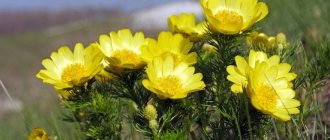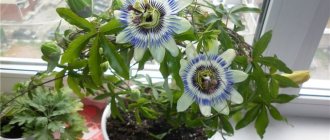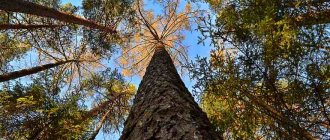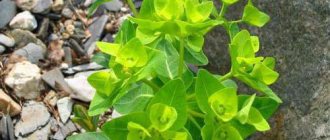Hello dear reader!
You can find many interesting plants in the forest. I want to introduce you to one of them – the club moss club – today.
They are sometimes called “green forest fires” because of the effect that club mosses have on the lower layer of the forest. Just don’t understand this as if they are a disaster for the forest. Quite the opposite! After all, even a real forest fire, but always a ground fire, often brings benefits to the forest... The seeds of many forest plants, and especially pine and larch, without this, often simply would not be able to germinate.
I think many people have seen the pine seed. A small, almost weightless lionfish. Now let's take a walk through the pine forest. Very often the soil here is covered with a continuous layer of green mosses.
And what, in your opinion, will be the fate of such a seed if it lands here in the moss? Yes, it simply will never be able to reach the soil. And it won’t germinate...
This is where mosses can come to the aid of a pine tree.
But before we talk about it, let's take a closer look at these interesting plants. And to get acquainted with this, I suggest choosing one of the most common representatives of this class of plants.
Moss club-shaped. Description. Photo
Club moss (Licopodium clavatum) is an evergreen herbaceous spore plant, a common inhabitant of coniferous forests, especially pine ones.
I wrote “an ordinary inhabitant” and thought about it... I remembered that even in the vicinity of our little Nikolsk I looked for a club moss for quite a long time in order to photograph it. I found it, of course. And in Yashkin Bor, and in other places. But nevertheless, this wonderful forest dweller has become, alas, very rare. And near large cities it disappears from the forest altogether. The reasons are quite banal - excessive collection and trampling.
The usual habitat of the club moss is a pine forest. However, you can find it in other types of forests. The green vines of this plant creeping along the ground are quite remarkable. The leaves are small, scaly, and tightly cover the shoot. The stem branches, while the main creeping stem stands out clearly, from which very similar, but not so long, branches out to the sides and upwards.
Some of these shoots, always raised above the ground, are crowned with yellow “spikelets.” These are sporangia where spores mature. In our hero they usually sit in pairs, but there can be more - up to five on one spore-bearing shoot.
It only seems that the moss is motionless. In fact, he is an eternal traveler. Creeping stems grow throughout the forest in all directions, they dive under the moss and lichen cover, and are able to go deeper into the soil, under the forest floor. In places of contact with the soil, the shoot forms adventitious roots. And then it appears again on the surface.
Growing radially in all directions, club mosses form “witch rings.” The outer of these rings consists of young shoots, on which sporangia are still rarely formed.
Inside this ring you can trace a second one - from older shoots. There are a lot of spore-bearing spikelets here.
And finally, the third ring is inside the second. It is formed by old shoots that are already dying. It turns out that the club moss is always in motion, it moves through the forest, “swimming.” Young sections of the stem are constantly growing, while old sections are constantly dying off.
This feature of the moss was noticed by our ancestors a long time ago, which is why they named the plant that way. Quicksand - quicksand - club moss . Actually, from time immemorial the club moss was only called the club moss. Its other relatives had different names: swamp juniper, ram, etc.
The Latin name of the genus of club mosses – Licopodium – arose this way. In German the plant was called "wolf's paw". In the 16th century, the botanist Tabernemontan translated this word into Latin. And it turned out to be Lycopodium.
Sections of the creeping stem that have sunk under the forest floor and given adventitious roots act as rhizomes. After all, club moss has no real rhizomes. From this area, new vines - creeping stems - can form and grow.
Description of the herb
Baranets is an evergreen creeping grass. This is a spore perennial with an underdeveloped root system, the height of which reaches 7-30 cm.
Article on the topic: Angelica forest - beneficial properties, description
The stems of the plant in question are erect or ascending, branching dichotomously, as well as rooting at the base and forming loose and rounded clumps. It is precisely by these external features that the club moss differs from other species of club mosses.
According to experts, the age of the clumps can exceed a hundred years, and their annual growth can vary between 1-4 cm.
The club moss has dark green, linear-lanceolate or lanceolate, leathery, sharp and hard leaves, which are densely arranged in a spiral and well pressed to the shoot axis.
In Central Russia, the spores of the plant in question ripen only in July-August.
How do mosses “fight” mosses?
Well, now we can tell you how mosses clear the forest of mosses. The lashes of club mosses traveling through the forest move in waves. The first wave - young shoots - are pioneers, “scouts”. It is followed by a second wave, the most numerous and dense shoots of which shade the mosses from the sun's color and suppress them. And when the third wave of mosses passes through the area, there is almost nothing left of the mosses, they die off.
The soil has been cleared of moss and seeds of other plants, such as herbs, can now germinate. And, of course, pine seeds! Yes, in a few years the mosses may return. But they are no longer afraid of grown-up young pines. This is how mosses clear the soil of mosses, creating conditions for the emergence of tree regrowth. This is why these interesting plants received the figurative definition of a “green forest fire.”
Reproduction and development cycle of clubmoss
In mosses (as, indeed, in mosses, ferns, horsetails) in the life cycle there is an alternation of two generations, sexual and asexual. I emphasize that these are independent, very different from each other, but still stages of the life of the same plant.
The plant that we see in the forest (and in the photo) is a sporophyte (asexual generation). And the sporophyte of the club moss reproduces asexually - by spores, tiny particles of dust without the slightest supply of nutrients. Reproduction is very unreliable. After all, out of tens of thousands of spores, perhaps only one will fall into favorable conditions, germinate and survive. And only a huge number of spores still allows one to achieve results.
But getting into favorable conditions is still half the battle! Some spores have a long dormant period and germinate underground. Such a spore can become covered with mineral particles of the soil, and can be moved deep into the soil by water, earthworms, and insects. And there, in the depths, after a few years (from 3 to 8!) it will sprout.
When the spore germinates, the next generation of the plant, the sexual one, grows from it. This is a very small formation called a gametophyte (or prothallus ). The shoot grows very slowly and after fifteen years reaches full size and matures. But even then it is not very large - only a few millimeters. And even more so, it doesn’t look like a sporophyte at all.
The growth - gametophyte - must have one more important meeting - with the hyphae of soil fungi. Only with their help does the gametophyte feed, because it is not capable of producing nutrients independently, especially in the soil. If there is no encounter with the mushroom, the shoot will die.
Other spores germinate very quickly, within a few days, directly on the surface. A very small (about 1 mm), pale green and translucent gametophyte is capable of photosynthesis. But it also receives a significant portion of its nutrients from the fungus. Such a gametophyte matures within one season.
Why is this generation called sexual? Yes, because in special organs on the germ, sex cells - gametes - mature: large immobile eggs and small, mobile spermatozoa equipped with flagella. Moreover, sperm mature a little earlier than eggs, which limits the possibility of self-fertilization.
For successful fertilization, droplet-liquid water is needed - raindrops or dew. The sperm swim towards the eggs and one of them fuses with the egg. The egg turns into a zygote. Sexual reproduction of the moss has occurred.
And then the zygote divides and germinates. A completely new living organism, a new sporophyte, will develop from it. In a few decades, if everything goes well, sporangia will appear on it and spores will ripen. And everything will happen again...
Of course, reproduction by spores is a very inefficient process, depending on many conditions. But it provides genetic diversity and promotes adaptation to changing environmental conditions.
However, relying on it alone would be downright dangerous. The clubmoss is club-shaped and is not supposed to be. However, more often the plant reproduces vegetatively. Remember - the lash of the creeping shoot “drew” under the moss, under the forest floor, and came into contact with the soil. And she gave me the roots. Now, even if the entire multi-meter body of the moss dies, and only this small section remains, the plant will survive and give rise to new vines.
How old is the club moss that we saw in the forest - hundreds? thousands? Probably no one will say this for sure. After all, reproducing vegetatively, growing every year in some areas and dying off in others, the club moss is practically immortal.
Useful properties and use of ram, contraindications
Botanical characteristics of the ram
The ram (lat. Huperzia selago) belongs to the club moss family (Lycopodiaceae). It belongs to the evergreen herbaceous plants and has a wide range of medicinal effects. The stem of the ram is erect, strictly stretching upward, reaching 30 cm in length. The leaves, or phylloids, are located closely, in many rows, have a needle-shaped, linear-lanceolate, entire-edged shape, up to 1 mm wide. The leaves are widened at the base, serrated towards the edges, and deep green in color.
Sporangia are located in the middle or upper part of the stem or in the axils of the leaves; spore-bearing spikelets (strobili) do not arise. Spores form in June. The buds form at the top of the stem, protecting themselves with small leaves. When autumn comes, the buds fall off. The root system of the ram is undeveloped and weak.
Sheep grows well in peat soil, mostly moist, and loves shade. It is not easy to plant the ram by sowing into the soil - few of its spores germinate. It is recommended to propagate the ram with the help of shoots, of which it has quite a lot. Sheep are harvested from August to September.
The sheep can be found in the coniferous forest belt of Russia, in Siberia, the Caucasus, Altai, the Carpathians and the Far East. It lives in swamps, coniferous forests, on rocks, on acidic, humus soils, as well as on crushed stone surfaces.
Useful properties of ram
Sheep grass contains a certain amount of alkaloids (0.12–1.3%), including: nicotine, annotinine, clavatin, lycopodine, acrifoline, pseudoselagine, clavatotoxin, selagine, selagonine, serratidine, huperazine and others. The aerial part of the sheep contains seratine-type triterpenoids, pectin compounds, many useful organic acids and fats, which include glycerides and oleic or palmitic acids.
Baranets also contain flavonoids, glycosides, resins and mucus, protein compounds, but the biological activity of this plant is determined by a huge amount of alkaloids.
Application of ram
In folk medicine, infusions of ram are prepared for the treatment of pulmonary tuberculosis, neurasthenia, diarrhea, cystitis, to stop seizures and for glaucoma, taken orally. Externally, with the help of ram infusions, skin diseases, alopecia and conjunctivitis are treated. In traditional Asian medicine, ram is used to treat tumors and blood diseases, memory disorders and myasthenia gravis.
Due to the content of huperazine A in some types of lamb, this plant has been used in the treatment of Alzheimer's disease. There is a practice of making preparations from lamb for the treatment of chronic alcoholism. Through this treatment, an aversion to drinking alcoholic beverages is caused. This technique is practiced in specialized medical institutions.
Various decoctions and infusions are made from the upper part of the plant to treat various diseases. After collecting the top part of the sheep in the summer-autumn period, the grass is dried at temperatures up to 50 degrees in dryers or under a canopy. The dried herb is stored in dry places, after which infusions of various healing effects are prepared from it.
We should not forget that the ram is poisonous. In frequent cases, it acts on the body as an emetic, laxative, and also an abortifacient. In case of possible poisoning, a person experiences nausea, vomiting, dizziness, chills, low blood pressure and various types of pain. Lamb infusions should be used on the recommendation of a doctor.
Recipe for ram infusion for the treatment of chronic alcoholism: pour 10 g of ram herb into 200 ml of hot water, then boil for 10 minutes over low heat. Let it brew, cool and strain. The shelf life of these decoctions is two days. Before taking the decoction, drinking alcohol is prohibited for 4 days. You should take 100 ml, then take 50 g of alcohol. After 10–15 minutes, the patient develops gag reflexes, causing disgust for this product.
Article on the topic: Zimozelen - beneficial properties, description
Moss club moss
The ram moss belongs to the ram family. It is a perennial, evergreen and herbaceous plant with erect, well-leafed stems. The leaves are linear-lanceolate, small, up to 1–2 mm wide and up to 10 mm long, stretching upward at an angle. The leaves grow densely close to each other, hard to the touch. A characteristic feature of the leaves is a barely noticeable white frame. New ram seedlings are given brood buds, which originate in the upper axils of the leaves.
The club moss is widespread in the Northern Hemisphere of the Earth: from Russia to the Far East. In Russia, it can be found in tundra zones, in coniferous forests, closer to mosses, as well as in subalpine phytocenoses. It grows profusely, occupying large areas of soil and creating the appearance of a large, overgrown bush.
Moss moss has some use in dyeing: the upper parts of this plant dye wool yellow. This plant is also widely used in medicine: it serves as a sedative for nervous disorders, an anthelmintic and an analgesic. Its decoctions are used externally in the treatment of psoriasis and skin diseases. You should not forget about the toxicity of this plant and use it only with a doctor's prescription.
Common ram
Common ram grows on acidic, podzolized soils in temperate climates throughout the Northern Hemisphere. This plant is by no means ubiquitous: it loves to grow among coniferous trees. The common ram is not afraid of cold and frost; it shows particular resistance to such conditions.
Common ram is widely used in the treatment of alcoholism. It not only treats this harmful human addiction but also removes toxins from the body, decomposed cells and destroys viruses and bacteria.
A recipe for making an infusion of common ram for parasites: pour five grams of common ram herb with one glass of boiling water, let it brew in a thermos for one day, then strain through a gauze bandage. You need to take 100 g of infusion three times a day before meals for a month.
Contraindications for ram
Infusions and decoctions of lamb are specific medicinal products, since the plant itself is poisonous: it is worth remembering that it can only be used with a doctor’s prescription. Use is contraindicated in cases of coronary heart disease, pneumosclerosis, atherosclerosis, emphysema, thyrotoxicosis, aortic aneurysm, coronary insufficiency, diabetes mellitus, as well as bronchial asthma, epilepsy, stomach ulcers, duodenal ulcers, kidney disease.
It is not recommended to use lamb for mental illness, brain diseases, liver disease, pregnancy, hernias, hemorrhoidal bleeding. It is prohibited for people over 60 years of age. When taking ram infusions, nausea, weakness, loss of strength and loss of consciousness may occur. If unpleasant consequences occur, the patient should take a horizontal position, raising his legs up, and bring a cotton swab with ammonia to his nose.
Education: Diploma in General Medicine and Therapy received from the University named after N. I. Pirogov (2005 and 2006). Advanced training at the Department of Herbal Medicine at the Moscow People's Friendship University (2008).
The meaning of club moss for humans
Since perhaps the most important thing that many of us are interested in in nature is the “benefit” or “harm” of a living creature for us, our loved ones, this issue cannot be ignored.
Large vertebrates do not eat clubmoss. It is believed that the cause is a poison contained in the plant and similar in effect to the famous poison curare. Invertebrates, however, feed on mosses without much damage.
And people only use the spores of this plant. It is used in medicine - still, mainly in folk medicine. Officially, only the use of spore powder (lycopodium) as a powder to prevent diaper rash in infants is recognized.
Moss moss spores are even used in metallurgy! After all, they are very flammable. So much so that if you pour a pinch of spores onto the flame of a candle or alcohol lamp, you will get a small firework, similar to a sparkler. Lycopodium is used in the mixture for this New Year's attribute (at least, it was used before).
And in metallurgy, molds for shaped casting were sprinkled with this powder. Upon contact with hot metal, lycopodium instantly burns, and a thin gas layer appears between the mold and the solidifying casting. They say that such castings do not even need to be polished...
Just a question: how long will it take to destroy the club moss so that there is enough lycopodium for everything?! But it will take several decades for a new, very small plant to emerge from a spore.
The club moss is also very sensitive to mechanical stress - for example, to trampling. And here is the result - the plant has become extremely rare, sometimes it is not easy to even find it in the forest. What can we say about the use of moss for decorative purposes - to decorate various rooms with garlands of it for the holidays, as was done before? Now you can get a large fine for this, and quite rightly.
Yes, the club moss is very decorative. Just let him decorate the forest better!
As for the powder... My diaper rash in early childhood was sprinkled with lycopodium
. But then buying powder at the pharmacy was very problematic. Today the situation has changed “exactly the opposite.”
But if you are going to collect lycopodium, please take scissors. And cut off only spore-bearing spikelets. We don’t need anything more from the club moss.
About other forest mosses, no less interesting, another time. The article was already quite lengthy. We will definitely talk about other interesting plants. Therefore, I advise you to subscribe to blog updates. You can do this, for example, by clicking on the picture - the link below.
If an article deserves a like on social networks, do this simple procedure by clicking on the appropriate buttons.
Don't forget to comment on the article. Every comment is interesting and important to me.
Best regards, Alexander Silivanov
Mode of application
Where to buy club moss? Finding such a plant in regular pharmacies is quite difficult. Therefore, many people order it through the World Wide Web.
It should immediately be noted that, like all club mosses, the common moss is a poisonous herb. Treatment with decoctions made from this plant is possible only in stationary conditions and under the strict supervision of specialists.
Most often, supporters of traditional medicine use the above-ground parts of the mentioned herb. They take them orally for neuroses, pulmonary tuberculosis and glaucoma. This plant is also very effective for metabolic disorders, as an anticonvulsant, laxative, anti-inflammatory and diuretic. In addition, it helps well with cystitis and is used as an anthelmintic and antitumor drug.
Article on the topic: European Dryakva - useful properties, description
In addition to taking the decoction internally, it is also used externally. As a rule, this remedy is used for conjunctivitis, skin diseases and alopecia. According to experts, this plant is effective even for infertility.
For medicinal purposes, the common ram is used not only in our country, but also in such an Asian country as China. However, to prepare medicinal extracts, residents of the Celestial Empire use a plant of a similar species, or more precisely, the serrated ram. It contains much more huperazine A than other club mosses. This plant is used to treat fever, tumors and blood diseases.
It should also be said that the herb in question is highly effective in senile memory impairment and the treatment of myasthenia gravis. In addition, drugs based on huperazine A have pronounced neuroprotective activity. Such drugs are very often used to treat Alzheimer's disease.










